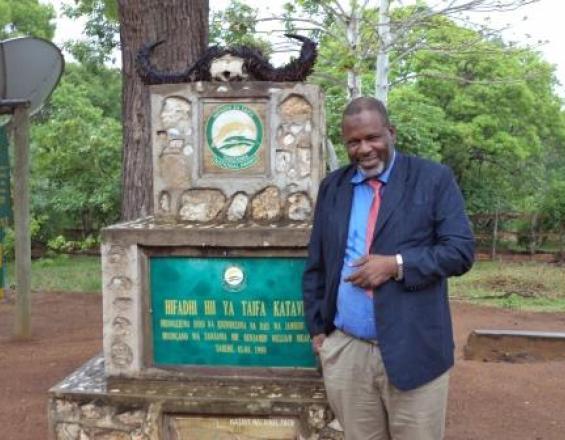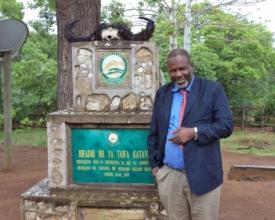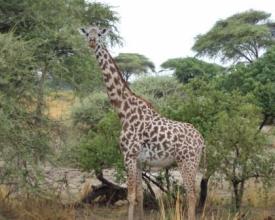
Integración de los aspectos del cambio climático en la planificación de la gestión de áreas protegidas en Tanzania

Esta solución se centra en la integración de los aspectos del cambio climático en el plan general de gestión del Parque Nacional de Katavi (Tanzania). Sirve como herramienta a disposición de los gestores de áreas protegidas para abordar los impactos del cambio climático sobre la biodiversidad y los ecosistemas del parque y las comunidades adyacentes; y para desarrollar la capacidad técnica de los gestores del parque en cuestiones relacionadas con el cambio climático.
Contexto
Défis à relever
Los retos abordados son tanto técnicos como sociales:
- Falta de reconocimiento del papel de las áreas protegidas en la consecución de los objetivos de adaptación y mitigación por parte de los actores clave.
- Acceso limitado a datos sobre el clima y la biodiversidad para la planificación de la conservación y el desarrollo
- Capacidades técnicas: escasa capacidad técnica para integrar las consideraciones del cambio climático en la planificación de la gestión de las áreas protegidas
Ubicación
Procesar
Resumen del proceso
Los seis componentes básicos están estrechamente relacionados.
Desarrollo de la capacidad de resistencia al cambio climático (BB1): La mejora de la capacidad de las partes interesadas aumentó claramente su participación en la evaluación de la vulnerabilidad al cambio climático y el uso de la tierra (BB2), el desarrollo de la estrategia de cambio climático (BB 3), la revisión del GMP
(BB 4) y la comunicación del PGE revisado (BB 5)
Del mismo modo, los conocimientos y habilidades adquiridos, y la información generada, durante la evaluación del uso de la tierra y la vulnerabilidad al cambio climático (BB2) son fundamentales para la revisión del PGE (BB 3) y el desarrollo de la estrategia de cambio climático (BB 4). La revisión del GMP (BB 3) y el desarrollo de la estrategia de cambio climático del parque (BB 4) contribuyen a mejorar la capacidad sobre la resiliencia al cambio climático (BB 1) y, en consecuencia, a mejorar las habilidades sobre la evaluación de la vulnerabilidad y el uso de la tierra (BB 2 ).
La comunicación de la estrategia de cambio climático del parque (BB 5) contribuye a mejorar la capacidad sobre la resiliencia al cambio climático del parque (BB 1), la evaluación de la vulnerabilidad al cambio climático y el uso de la tierra (BB 2), el desarrollo de una estrategia de cambio climático del parque (BB 4) y también la revisión del GMP (BB 3).
Bloques de construcción
Refuerzo de las capacidades de resistencia al cambio climático
El objetivo de este bloque es capacitar a los gestores de los parques en materia de cambio climático mediante talleres centrados en temas muy específicos de las cuestiones relacionadas con el cambio climático que se plantean en los parques.
En 2017 se celebraron una serie de talleres de capacitación en Mpanda y Sumbawanga para concienciar sobre conceptos clave relacionados con el cambio climático, incluidos los impactos, la vulnerabilidad y la resiliencia en relación con las áreas protegidas. A los talleres asistieron delegados del Parque Nacional de Katavi, la Reserva de Caza de Lwafi, el Consejo de Distrito de Mpanda y ONG conservacionistas que trabajan en Mpanda y Rukwa, como LCMO.
Los talleres proporcionaron a los participantes información y conocimientos clave sobre aspectos climáticos necesarios en los próximos pasos de la integración del cambio climático en el Plan General de Gestión del Parque.
Factores facilitadores
- Disponibilidad de partes interesadas, motivadas y comprometidas
- Enfoques y estrategias de facilitación eficaces
Lección aprendida
- El desarrollo de capacidades no debe ser un acontecimiento puntual, sino una empresa continua destinada a mejorar la capacidad tanto de los gestores de los parques como de las partes interesadas, incluidas las comunidades locales que viven junto a las áreas protegidas.
- El compromiso y la mayor capacitación de las comunidades son importantes para la sostenibilidad de la solución.
- El proceso debe ir acompañado de un seguimiento y una evaluación que garanticen la mejora real de la concienciación y la capacidad.
Evaluación de la vulnerabilidad al cambio climático y el uso del suelo
El objetivo de este bloque es evaluar la vulnerabilidad de la biodiversidad ante factores de estrés climáticos y no climáticos (por ejemplo, cambios en el uso del suelo). La evaluación es un requisito previo a cualquier acción para medir el estado de conservación de la biodiversidad y la resistencia al cambio climático. Estas evaluaciones también ayudan a orientar mejor la identificación de intervenciones adecuadas de adaptación al cambio climático.
La evaluación de la vulnerabilidad al cambio climático y del uso de la tierra se hizo recorriendo el parque y mediante revisión documental. Mientras que las visitas sobre el terreno tenían como objetivo obtener información crucial a través de la observación, el estudio teórico se llevó a cabo para aumentar la información sobre el terreno. La evaluación fue dirigida por expertos acompañados por gestores del parque, expertos en recursos naturales del distrito y ancianos del pueblo adyacente que conocen mejor el parque y las zonas circundantes.
Factores facilitadores
- Inventario de conocimientos tradicionales sobre biodiversidad y cambio meteorológico / climático.
- Disponibilidad y acceso a datos científicos de referencia sobre biodiversidad y cambio climático.
- Capacidad de visualizar el estado pasado, presente y futuro de la biodiversidad en el contexto de los factores de estrés climáticos y no climáticos.
Lección aprendida
La revisión de los datos existentes sobre el cambio climático es fundamental para comprender las tendencias pasadas y futuras del cambio climático a escala regional y nacional.
Las visitas al parque y sus alrededores ayudan a obtener información sobre el estado de los usos del suelo y la biodiversidad/ecosistemas. En concreto, la observación directa proporciona información sobre las amenazas y retos a los que se enfrenta la biodiversidad y también sobre los signos visibles de sequías, inundaciones, etc. inducidas por el clima.
Las comunidades locales, en particular los aldeanos que llevan más tiempo viviendo cerca o en los alrededores del Parque Nacional, conocen mejor los cambios locales en el clima y la biodiversidad. Por ello, para diseñar estrategias de adaptación adecuadas, es fundamental recopilar esta información para validar y complementar los datos globales y regionales y desarrollar una visión con las comunidades.
Revisión del Plan General de Gestión del Parque para incluir aspectos de resiliencia climática
Este bloque aborda los trabajos de revisión del plan de gestión para que integre aspectos relacionados con la resiliencia al cambio climático.
En 2016 se organizó un taller de partes interesadas, facilitado por un experto, para revisar el GMP del parque. Al taller asistieron gestores del parque, incluidos ecologistas, conservacionistas de las reservas de caza circundantes, ONG y programas que operan en el ecosistema Katavi-Rukwa.
La revisión identificó el cambio climático entre las principales amenazas a las que se enfrenta la biodiversidad. Además, se incluyó la resiliencia al cambio climático en la lista de objetivos de gestión con el fin de incluirla entre los objetivos del GMP y reducir así su amenaza para la biodiversidad y el ecosistema. La dirección del parque y las partes interesadas acordaron, y así se reflejó en el GMP revisado, que debía desarrollarse una estrategia detallada sobre el cambio climático en el parque para abordar mejor las cuestiones relativas a la resiliencia al cambio climático.
Factores facilitadores
Entre los factores facilitadores clave en esta BB se incluyen:
- Sensibilización sobre los efectos del cambio climático y las estrategias de adaptación de las áreas protegidas.
- Facilitación eficaz del proceso de revisión del PGE por las partes interesadas
- Participación efectiva de las partes interesadas en el proceso de revisión
Lección aprendida
Para integrar mejor los aspectos del cambio climático, es fundamental:
- Revisar las amenazas a la biodiversidad existentes para incluir el cambio climático.
- Revisar los objetos de gestión para captar la resiliencia al cambio climático
- El marco de planificación de la gestión de las áreas protegidas debería revisarse para incluir el cambio climático. Esto permitiría integrar el cambio climático durante el desarrollo del GMP, en lugar de durante el proceso de revisión.
Desarrollo de una estrategia de cambio climático para el parque
Tras la evaluación del cambio climático y la vulnerabilidad, y la revisión del PGE para incluir aspectos relacionados con el cambio climático, un consultor elaboró un borrador de objetivos y estrategias de adaptación al cambio climático que, una vez aplicados, mejorarían la resiliencia del parque al cambio climático.
En septiembre de 2017 se celebró en Mpanda un taller de partes interesadas para validar y aumentar el proyecto de objetivos y estrategias de adaptación al cambio climático. Al taller asistieron gestores del Parque Nacional de Katavi, conservacionistas de la Reserva de Caza de Lwafi, funcionarios del Consejo de Distrito de Mpanda y representantes de ONG que operan en el paisaje de Rukwa-Katavi. Las aportaciones de las partes interesadas se utilizaron para desarrollar los objetivos y estrategias de adaptación en una estrategia de cambio climático del parque que detalla la meta y los objetivos de la estrategia, las estrategias de adaptación y los planes de aplicación y seguimiento. Este último describe una lista de indicadores y parámetros clave para supervisar los cambios en la vulnerabilidad y la resiliencia.
En octubre de 2017 se celebró otro taller en Sumbawanga para validar la estrategia de cambio climático. Al taller asistió el mismo grupo de partes interesadas que participó en el otro taller. La estrategia final de cambio climático del parque debía integrarse y adjuntarse al GMP.
Factores facilitadores
- Participación de las partes interesadas con conocimientos sobre la variabilidad y el cambio climáticos y la biodiversidad
- Facilitación por un experto en cambio climático y recursos naturales
- Acceso a información actualizada sobre el clima (y la biodiversidad)
Lección aprendida
- La participación de las partes interesadas es clave para diseñar medidas de adaptación adecuadas con el potencial de mejorar la resiliencia al cambio climático. Por ello, las partes interesadas, incluidas las comunidades adyacentes a las áreas protegidas, deben participar en la identificación y validación de las medidas de adaptación y mitigación del cambio climático.
- La identificación de medidas relevantes de adaptación y mitigación requiere que el proceso sea facilitado por un experto cualificado en cambio climático con un buen conocimiento del contexto regional, nacional y local.
- La disponibilidad de datos de referencia actualizados, tanto científicos como autóctonos, sobre los aspectos relacionados con el cambio climático contribuye al diseño de las medidas de adaptación pertinentes.
Comunicación de la estrategia del Parque sobre el cambio climático a las partes interesadas
El objetivo de este bloque es dar a conocer la estrategia de cambio climático a gran escala a través de la comunicación por medios adaptados especialmente a las realidades de la zona del parque. Los medios a utilizar dependen del nivel de intervención. Por ejemplo, la radio comunitaria y los carteles pueden utilizarse para educar a la población local; las plataformas en línea son útiles para un público amplio a escala nacional e internacional; y los folletos son útiles para los visitantes, etc.
Factores facilitadores
Estrategias de comunicación adecuadas que tengan en cuenta, por ejemplo, los niveles de alfabetización, los conocimientos lingüísticos y otros factores socioculturales.
Lección aprendida
- La comunicación de la estrategia de cambio climático garantiza que las partes interesadas sean conscientes de los aspectos relacionados con el cambio climático y que se genere su interés y se garantice su compromiso de participar en la aplicación y el respeto de la estrategia y del GMP como herramienta de gestión del parque.
- La comunicación de la estrategia de cambio climático permitirá a las partes interesadas dar su opinión, a través del seguimiento y la evaluación, sobre la eficacia de la estrategia para alcanzar los objetivos de resiliencia previstos.
Impactos
Las repercusiones positivas de la solución son tanto sociales como medioambientales, ya que permitió a los gestores de los parques
- Comprender mejor los impactos del cambio climático en los sistemas sociales y ecológicos y la vulnerabilidad de la biodiversidad y los ecosistemas.
- Identificar las estrategias prioritarias de adaptación y mitigación de los parques.
- Apreciar el papel que pueden desempeñar las áreas protegidas en el apoyo a la adaptación de la naturaleza y las comunidades locales, manteniendo el flujo de servicios ecosistémicos y mitigando los impactos del cambio climático mediante el secuestro de carbono.
Beneficiarios
Entre los beneficiarios de esta solución figuran:
- Planificadores y gestores de la conservación del Parque Nacional de Katavi y la Autoridad de Parques Nacionales de Tanzania
- Conservacionistas que trabajan en el ecosistema Rukwa-Katavi o en sus alrededores

